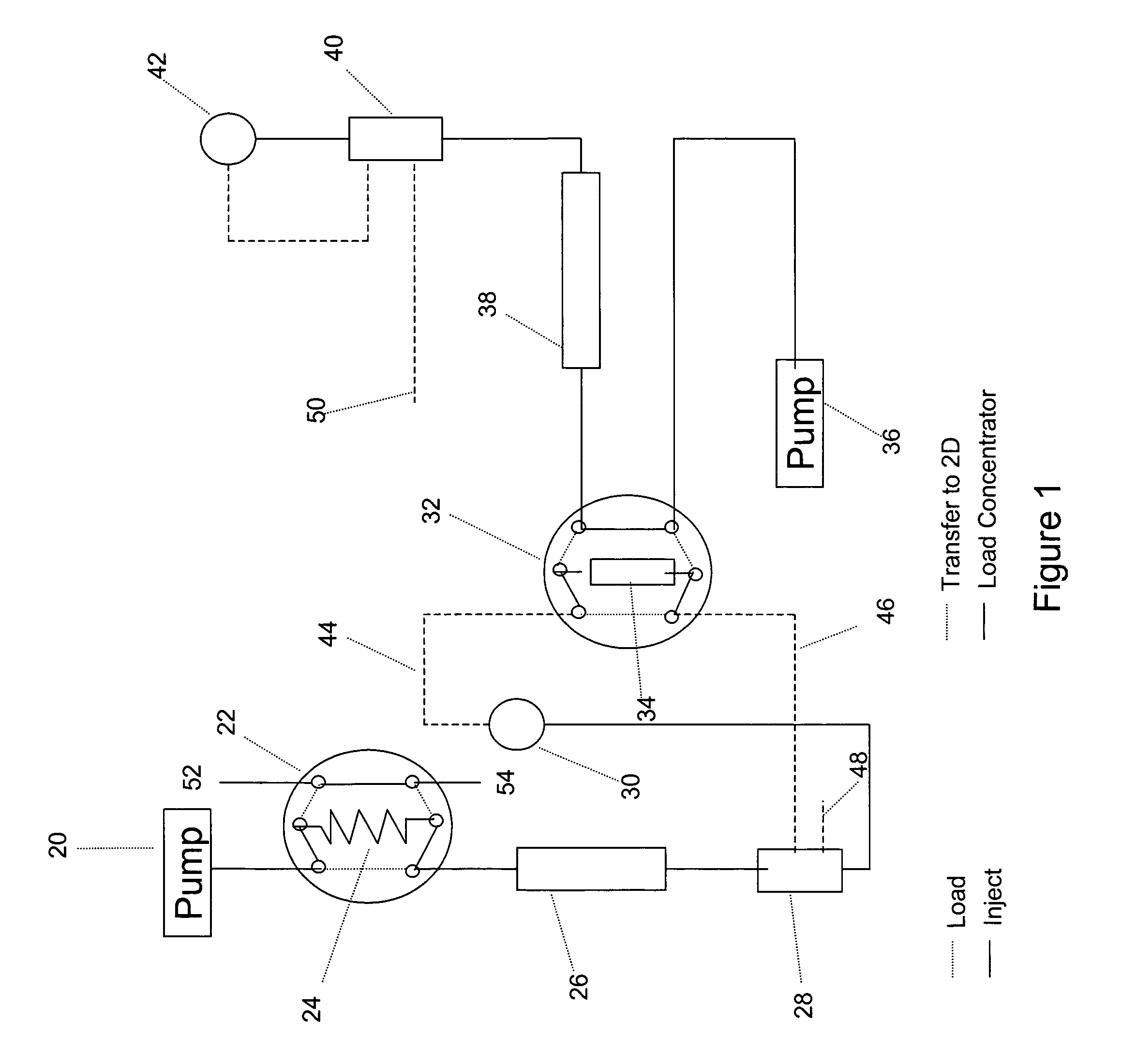Multidimensional chromatography apparatus and method
a chromatography apparatus and multi-dimensional technology, applied in the direction of machines/engines, liquid/fluent solid measurement, peptides, etc., can solve the problems of loss of trace ions of interest, focus or concentrate matrix ions which may not be desirable, loss of trace ions recovery, etc., to achieve the effect of improving the reproducibility of peak response and retention time and the variance of retention tim
- Summary
- Abstract
- Description
- Claims
- Application Information
AI Technical Summary
Benefits of technology
Problems solved by technology
Method used
Image
Examples
example 1
[0069]This example illustrates the limitation of prior art methodology for bromate analysis in the presence of matrix ions. A commercially available Ion chromatograph system ICS 3000 from Dionex Corporation was used for this work. The first dimension column was a 4 mm AG19 / AS19 column that was operated using a KOH gradient at 30 C as outlined below.
[0070]
TimeGradient (mM)01010102545304530.1103510Matrix Concentration (ppm of Cl and SO4)A0B50C100D150E200F250
[0071]A 4 mm ASRS Ultra II suppressor was used for this work and was operated using a constant current of 113 mA. A 500 uL injection loop was used for this work. The effect of matrix concentration (NaCl and Na2SO4) on the bromate peak was studied using the first dimension setup. FIG. 5 shows an overlay of the chromatograms generated using the various matrix samples. The peak labeled 1 is a 5 ppb sample of bromate. It is clear that as the matrix concentration increased from 0 to 250 ppm, the bromate peak became wider and it was diff...
example 2
[0073]In this example, the bromate sample was analyzed as per the present invention. The first dimension separation conditions were similar to what was outlined in Example 1.
[0074]A cut volume from about 7.5 to 9.5 minutes (2 mls) was diverted from the first dimension into a TAC-ULP1 concentrator column and the retained ions were analyzed in the second dimension using a 2 mm AG19 and AS19 column operated at 0.25 ml / min using a KOH gradient at 30 C as outlined
[0075]
First dimensionSecond dimensionTime (min)Gradient (mM)Gradient (mM)01010101019.5102545304530.11034.545351045
[0076]A 2 mm ASRS Ultra II suppressor was used at 29 mA. The same bromate sample (5 ppb of bromate) from FIG. 6 was used in this work. The results indicated excellent recovery of bromate in the presence of matrix ions with no impact on peak shape as shown in FIG. 7 (Inset A is in the presence of additional matrix ions and B is in DI water).
example 3
[0077]The following table compares the peak response of 5 ppb bromate in reagent water in the first dimension versus the second dimension approach of the present invention.
[0078]
Peak responseDimension(peak area)SensitivityFlow rateFirst0.006311ml / minSecond0.02443.870.25ml / min
[0079]It should be noted that the sensitivity in the above example increased roughly four fold as predicted by theory and was proportional to F the ratio of the flow rate the first dimension to the second dimension.
PUM
| Property | Measurement | Unit |
|---|---|---|
| inner diameter | aaaaa | aaaaa |
| internal diameter | aaaaa | aaaaa |
| diameters | aaaaa | aaaaa |
Abstract
Description
Claims
Application Information
 Login to View More
Login to View More - R&D
- Intellectual Property
- Life Sciences
- Materials
- Tech Scout
- Unparalleled Data Quality
- Higher Quality Content
- 60% Fewer Hallucinations
Browse by: Latest US Patents, China's latest patents, Technical Efficacy Thesaurus, Application Domain, Technology Topic, Popular Technical Reports.
© 2025 PatSnap. All rights reserved.Legal|Privacy policy|Modern Slavery Act Transparency Statement|Sitemap|About US| Contact US: help@patsnap.com



